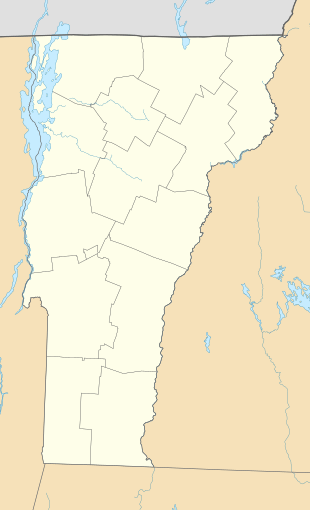Naulakha (Rudyard Kipling House)
|
Naulakha (Rudyard Kipling House) | |
 | |
| Location | Off U.S. 5, Dummerston, Vermont |
|---|---|
| Coordinates | 42°53′55″N 72°33′51″W / 42.89861°N 72.56417°WCoordinates: 42°53′55″N 72°33′51″W / 42.89861°N 72.56417°W |
| Area | 11 acres (4.5 ha)[1] |
| Built | 1892 |
| Architect | Henry Rutgers Marshall |
| Architectural style | Shingle Style |
| Governing body | Private |
| NRHP Reference # | 79000231 |
| Significant dates | |
| Added to NRHP | April 11, 1979[2] |
| Designated NHL | November 4, 1993[3] |
Naulakha, also known as the Rudyard Kipling House, is a historic Shingle Style house at 707 Kipling Road in Dummerston, Vermont. The house was designated a National Historic Landmark in 1993 for its association with the author Rudyard Kipling (1865-1936), who had it built in 1893 and made it his home until 1896. It is in this house that Kipling wrote Captains Courageous, The Jungle Books, A Day's Work, and The Seven Seas, and did work on Kim and The Just So Stories.[1] Kipling named the house after the Naulakha Pavilion, situated inside Lahore Fort. The house is now owned by the Landmark Trust, and is available for rent.
Name
Etymologically Naulakha means nine lakhs or nine hundred thousand being the amount of rupees incurred for the cost of construction of the building. Another prominent example of similar use of the name is Naulakha Temple in Deoghar, Baidyanathdham (Jharkhand), India.[4] The Mughal architecture of the monument had inspired him during his earlier stay (between 1882–1887) in Lahore.[5]
Description
Kipling himself described the building and its construction in his autobiography, Something of Myself:
[In the summer of 1893] there came out of Quebec Jean Pigeon with nine other habitants who put up a wooden shed for their own accommodation in what seemed twenty minutes, and then set to work to build us a house which we called ‘Naulakha.’ Ninety feet was the length of it and thirty the width, on a high foundation of solid mortared rocks which gave us an airy and a skunk-proof basement. The rest was wood, shingled, roof and sides, with dull green hand-split shingles, and the windows were lavish and wide. Lavish too was the long open attic, as I realised when too late. Pigeon asked me whether I would have it finished in ash or cherry. Ignorant that I was, I chose ash, and so missed a stretch of perhaps the most satisfying interior wood that is grown. Those were opulent days, when timber was nothing regarded, and the best of cabinet-work could be had for little money.[6]
Stylistically the house is an architecturally cross-cultural and distinctive building, resembling in part a South Asian Indian bungalow, albeit executed in the then-fashionable American Shingle style. The property and house were laid out by Kipling to maximize the family's privacy. Although it commands spectacular views to the Connecticut River and Mount Monadnock to the east, the house as built had only a single entrance and was only one room deep, with a hallway running along the rear. The house is approached by a tree-lined drive from an iron gate set between fieldstone pillars whose construction Kipling watched. The property includes a number of outbuildings and facilities built by the Kiplings, including a greenhouse, carriage barn, and tennis court.[1]
The Kiplings, while on their honeymoon in 1892, visited Caroline Starr Balestier Kipling's parents in nearby Brattleboro. Taken by the countryside, the couple purchased this property from Caroline's brother, and had the house built on it in 1893 to a design by Henry Rutgers Marshall, with significant input from Kipling. They lived here until 1896, when a dispute with a hot-tempered neighbor led to court proceedings and an avalanche of publicity. They attempted to return in 1899, but illness on the sea crossing from England frustrated the plan. The property was owned for much of the 20th century by members of the Holbrook family, who in 1992 sold it to the Landmark Trust,[1] a preservation organization that restores historic properties and makes them available to the public. The property has largely been restored to its appearance as of the Kipling's ownership, and includes artifacts belonging to the family.
The house was listed on the National Register of Historic Places in 1979, and was declared a National Historic Landmark in 1993.[3][2]
See also
- List of National Historic Landmarks in Vermont
- National Register of Historic Places listings in Windham County, Vermont
References
- ↑ 1.0 1.1 1.2 1.3 David C. Tansey (April 1993). "National Register of Historic Places Inventory-Nomination: Naulakha / Rudyard Kipling House" (pdf). National Park Service. and Accompanying 14 photos, exterior and interior including one with Rudyard Kipling, from 1895, 1905 and 1992 PDF (32 KB)
- ↑ 2.0 2.1 "National Register Information System". National Register of Historic Places. National Park Service. 2007-01-23.
- ↑ 3.0 3.1 "Naulakha (Rudyard Kipling House)". National Historic Landmark summary listing. National Park Service. Retrieved 2008-02-18.
- ↑ Kipling, Rudyard (1996) Writings on Writing. Cambridge University Press. ISBN 0-521-44527-2. p.36 and p.173
- ↑ Robert D. Kaplan (1989) Lahore as Kipling Knew It. The New York Times. Retrieved on 9 March 2008
- ↑ Rudyard Kipling, Something of Myself: for my friends known and unknown, London: MacMillan and Co., 1951 (first published 1937). p. 114-115
External links
| ||||||||||||||||||||||||||
| ||||||||||||||||||||||||||